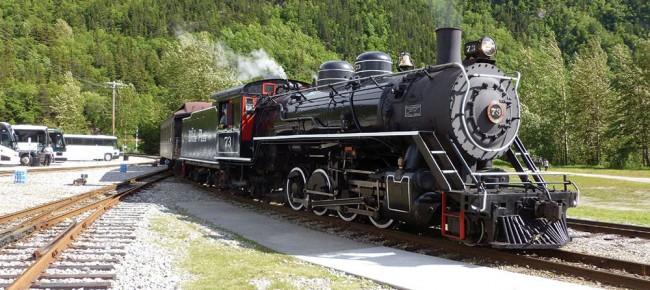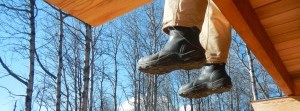
Photo Credit: Hilary Crowley
Relax by Rail Travels through the North by train and ferry
I recently travelled by rail from Prince George to Prince Rupert, a journey that should have taken 12 hours. The purpose of this journey was to reach Prince Rupert and from there take the Alaska ferry up to Skagway to catch the narrow-gauge White Pass & Yukon Railroad towards Whitehorse.
One of the highlights of this trip was chatting with other passengers. One young enthusiast explained what each of the signals meant and received information through his radio concerning oncoming freights so he could predict each of our stops. He was from the States and was in the process of riding all the unique and threatened rail routes in the world.
A bearded passenger boarded in Smithers. He was a prospector and had a claim further along the line. Somewhere between Terrace and Prince Rupert, the train slowed to a halt and let this gentleman off. There wasn’t a building or any sign of civilisation in sight. As soon as he alighted from the train, he stepped off the tracks and disappeared into the forest. Within a few minutes we crossed a sparkling creek, presumably where he panned for gold and drew his water.
My travelling companions were my sister Helen and brother-in-law Peter from England. We took advantage of the observation car, enjoying views of numerous lakes as well as bears and deer. Further west, snow-clad peaks rose to the sky and salmon rivers gushed beside us. “Surely we have time to connect to the 11pm ferry tonight,” said Peter. We were due in at 8pm. But we were glad we had heeded advice to spend a couple of days in Prince Rupert when our train arrived three hours late, after the ferry had left. The only problem with passenger rail today is that it has to give priority to freight trains, making it difficult to keep to schedule.
A grizzly visit
Prince Rupert is well worth a visit in its own right and a trip to the Khutzeymateen Grizzly Bear Sanctuary is not to be missed. Our Khutzeymateen tour cost $200 and took six hours. The weather was spectacular with clear skies and sun. This turned out to be one of the major highlights of our trip. If you are ever in Prince Rupert, don’t hesitate to splurge and join one of these spectacular tours.
We travelled in comfort by catamaran, travelling north through Chatham Sound then up the Work Channel. This is a prime whale-viewing area and excited shouts went up as we saw a humpback whale breach in front of us. We watched it surface several times before it dove deep, showing its massive tail flukes. The guide explained, “They surface five times before diving and stay under for about 10-20 minutes, then surface again, repeating the show.” We observed this at close quarters while eagles soared overhead. We then left Work Channel and carried on north to the Khutzeymateen.
This is a long fjord where about 50 grizzly bears find sanctuary. The grizzlies come down to feed on the sedge grass. We observed a total of seven bears but the best sighting of all was a sow with two young cubs. They seemed totally unconcerned about us. One of the cubs came down to the shore in front of us for a drink. After a while the sow climbed up onto a rock, turned her back to us, and defecated over the edge. After finishing her business, she squatted down on the rock and wiped her buttocks on the surface before climbing down and continuing to feed with her cubs.
On the way back we saw two pods of orcas as well as sea-lions and more eagles. We returned to Rupert with life-long memories and stories to tell.
North to Alaska
Next day we caught an early-morning ferry north to Juneau, spending one night on board and one in Juneau. The ferry arrived at Skagway in the late afternoon. This is a charming heritage town with saloons and Victorian facades down the main street. The main attraction is the Whitepass-Yukon Railroad, which crosses the main street close to the harbour. Skagway bustles with activity. Our choice of hotel was the Skagway Inn which was a brothel in its heyday. I had Alice’s room.
We were excited to board the Klondike Railway next morning and settle into our gold and green Victorian-style coach. Sun was shining on the Coast Mountains as we hung out on the small platform behind the coach snapping pictures of the unfolding rugged scenery, including trees stunted by the harsh climate. We travelled through snow in June. The route climbs 20 miles from sea level to 873 m at White Pass Summit, crossing canyons on high trestles, clinging to cliffs around bends and tunnelling through mountains. It climbs up the Coast Mountains to reach the summit before the gradual descent to Bennett Lake and Carcross. At Bennett station passengers are treated to a hearty lunch and have enough time to explore and climb to the terminus of the Chilkoot Trail.
The railroad was built to serve the Klondike gold rush. Gold was found where the Yukon and Klondike rivers meet in 1896. The Tlingit Nation controlled the Chilkoot Pass trade route from the ocean at Skagway over the Coast Mountains and into the interior. This 33-mile trail links tidewater at Skagway to the headwaters of the Yukon River at Summit and Bennett Lakes, from where the prospectors could navigate to Dawson City. The longer but less steep route was the 45-mile White Pass Trail, which enabled the use of pack animals. This is the route the railroad took the following year. Thousands of men and women risked their lives to trek north over these trails in hopes of finding their fortune.
Over the Pass
The sea voyage to Skagway was the easy part before carrying tons of supplies on their backs up the gruelling Chilkoot Pass, which often required 20 trips or more. On arrival at Bennett Lake, the next task was to build boats to carry people and gear down the Yukon River. Bennett became a tent city with 10,000 people camped there in the winter of 1897-98. Over 7,000 boats were built but before reaching Dawson they had to navigate the Whitehorse rapids. Several boats were crushed there. By the time these hungry and worn-out prospectors reached Dawson City most of the claims had already been staked by earlier settlers. Many of these disillusioned stampeders sold their gear to raise enough money to take the next steamer home.
Construction on the White Pass Yukon Railroad began in May 1898 and took 26 months to complete. The rails reached Bennett Lake in 1899 and Whitehorse in 1900. By then the height of the gold-rush had passed. During World War Two the railway carried supplies for the Alaska Highway construction. The railroad was operated by steam until 1954. In 1982 metal prices dropped, causing mines to close, and rail traffic ceased. In 1998 the railroad re-opened as a heritage tourist attraction.
The White Pass summit marks the US/Canadian border. Next is Summit Lake and from there the tracks gradually descend to Fraser, BC, and on to Bennett Lake. Partway along the lakeshore we cross into the Yukon Territory. At Carcross, a bus takes us the last 43 miles to Whitehorse.
Our journey had begun at Summit Lake, north of Prince George, and continued by rail past the Summit Lake at the summit of White Pass, and eventually took us to yet another Summit Lake, north of Fort Nelson, on our return journey.




